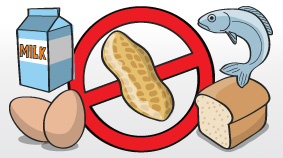Food hypersensitivity, also known as food allergy is an abnormal immunological reaction of the body to certain food items. This abnormal immunological reaction is repeatable, which means that every time the food is consumed you face the same allergy. There are two different types of reaction: IgE allergic reactions and Non-IgE allergic reactions.
IgE mediated allergic reactions: This reaction contains an antibody, called IgE, that circulates in the blood. It can be detected by analysing an allergy history accompanied with a blood test or skin-prick test. When going under skin prick tests, a drop of the alleged food is placed on the skin and pricked. Rashes, hives, asthma, vomiting and swelling are some common symptoms of IgE reactions. The most dangerous reaction, known as anaphylaxis, can result in cardiac or respiratory failure. In some rare cases, IgE allergic reactions can be life-threatening. It is estimated that 2% - 4% of 1-3-year-old kids suffer from food hypersensitivity.
Non-IgE mediated allergic reactions: This reaction develops more slowly, say about 2 hours up to a couple of days. There is no blood test or skin prick test available to aid diagnosis IgE mediated allergic reactions. The finding of the reaction is reliant by taking an allergy focused history along with an elimination food diet that leads to symptom improvement. Eczema, diarrhoea, vomiting, abdominal pain, constipation and faltering growth, and redness around the anus are some symptoms of non-IgE reactions.
There is a varied range of food items that could be allergic for kids. The most common ones are: milk, peanuts, cereals containing shellfish, gluten, fish and soybeans, eggs and tree nuts. Sometimes kids also have food allergic reactions to lupin, sesame and kiwi.
The best way to handle the food hypersensitivity / food allergy is to avoid the food, which is causing the allergy. Some kids with food allergies will need to eliminate the food completely. Others may be able to tolerate small quantity of the food they are allergic to. However, it is must that you discuss the eliminated diet with an adequately qualified healthcare professional. Incorrect avoidance of food diet can cause major nutritional consequences.
Found this information useful? You can learn more about your child’s good health by joining Shaw Academy’s Child Nutrition program. To know about this, click here. To know more about Shaw Academy Reviews online, you can browse on their Wikipedia page.

No comments:
Post a Comment